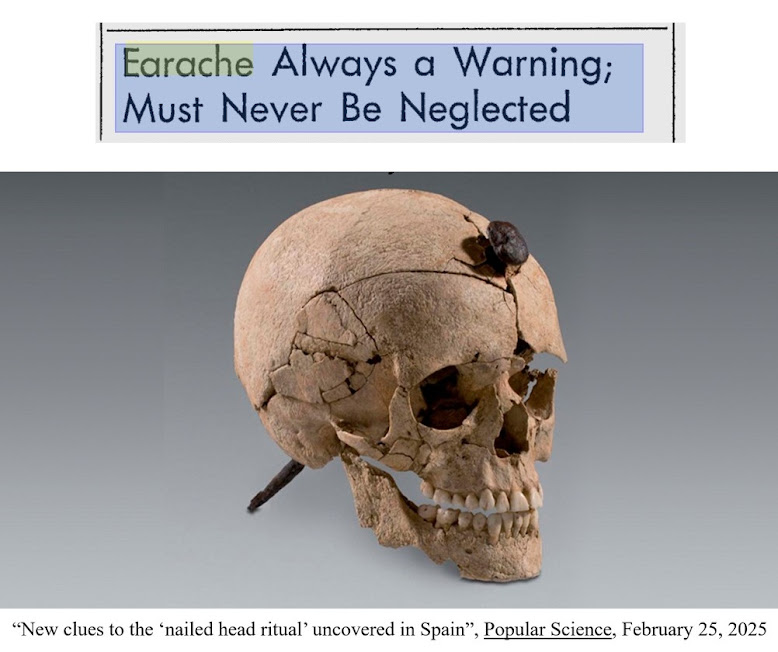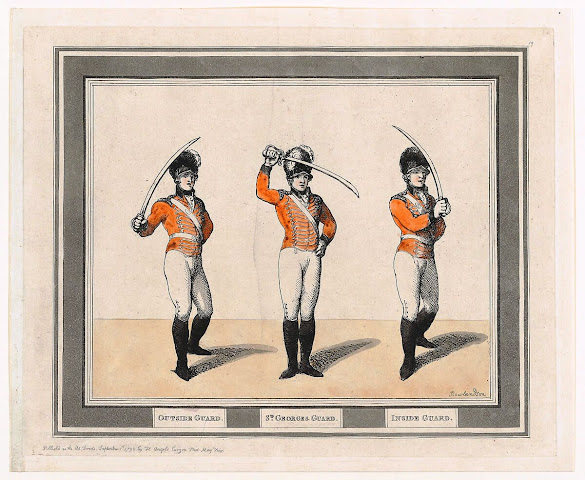
This skull, pierced with an iron nail, belonged to a young man who died in the late 3rd century or early 2nd century BCE, aged between 16 - 18
I
know, I know, I promised you an article on tallow this week, but unfortunately
this past Sunday I woke up with a serious pain in my head, almost as if someone
had driven a really big nail, right through my skull. Kinda like the poor guy in the title picture
above. So, on Tuesday I ended up going
to urgent care, which says a lot, since I avoid doctors like the plague, and it
turned out I had sinusitis and otitis media,
otherwise known as a middle ear infection.
Oh, ... how fun!
The urgent care doctor was kind enough to send me home with a couple of prescriptions and a few sheets of instructions. The part of the instructions that caught my attention the most was this line “Otitis Media, right ear (H66.91) – High risk of morbidity without treatment”.
Say
what!? It’s an ear infection, what is this
high risk of morbidity stuff? Medically
speaking, a “high risk” percentage is a probability of an event or
situation occurring that is greater than the average risk; a lifetime risk of
20% or greater is considered high. Wow,
that means as many 1 out of 5 cases of untreated otitis media can lead to
death! Yikes, although, if you look at
it in a backwards way 80% of sufferers survive.
I
did a little research and besides the risk of deafness, unchecked middle ear
infections, can lead to mastoiditis, an infection of the spongy mastoid bones
containing air-filled spaces called mastoid cells, and meningitis.
However,
before the advent of effective antibiotics in the early 1940s, the treatment
for otitis media was primarily focused on prevention, relieving pain and
promoting drainage of accumulated fluid, either through the eustachian tubes
(also known as ear canals), or through the outer ear canal; by spontaneous
rupture of the eardrum, or through a surgical intervention called myringotomy (the
cutting a small opening in the eardrum).
Most
middle ear infections come as an after effect of a respiratory infection, such
as colds, measles or other contagious fevers.
Respiratory infections can irate you eustachian tubes and cause swelling
and fluid buildup in your middle ear, causing pressure and pain to increase. The
bacteria or viruses causing the respiratory infection (fungi can also cause ear
infections, but that is less common) can travel into the eustachian tubes and
middle ear, where they begin to set up shop. So, the best way to prevent ear infections is
to prevent, or least reduce the severity, of colds, coughs and sneezing. Dr. Anh Nguyen-Huynh recommends the following...
(for more go HERE)
· Drink
warm liquids, like tea with honey. This
will soothe swollen membranes, and swallowing should help to open the
eustachian tubes.
· Stay
hydrated. Drink lots of fluids.
· Irrigate
your sinuses with saline solution or a neti pot.
· Take
decongestants to shrink the swelling of the nasal membranes which are blocking
the drainage.
· Get
plenty of extra rest.
Many
times this will prevent a middle ear infection, but if it doesn’t, the good
news is, that if caught early, most ear infections clear up by themselves. But if they don’t, you can try these to help
with reducing the inner ear pressure and pain.
· Use
hot and cold compresses, alternating every 30 minutes.
· Use
ibuprofen or acetaminophen to reduce pain.
· Change
your sleeping position, if your ear infection is limited to one ear, try
sleeping on your other side, so that your affected ear is up. If both ears are affected sleep on your back. In either case use more than one pillow so
that your head and ears are higher than the rest of your body. This will help to drain fluids.
· Loosen
and stretch your neck muscles, since when you have an ear infection the muscles
around your ear canal can swell, adding to the pressure and pain in your ears.
Ø Rotate
your head in slow circles.
Ø Drop
one ear towards your shoulder. Then drop
the other.
Ø Shrug
your shoulders up and down.
Ø Gently
open your mouth as wide as possible and hold it for a few seconds.
If
the ear infection doesn’t clear up within two to three days, if your ear is
very painful, or if you have a fever over 104o F (40o C),
Dr. Nguyen-Huynh advises contacting your healthcare provider.
I hope that you enjoy learning from this resource! To help me to continue to provide valuable free content, please consider showing your appreciation by leaving a donation HERE. Thank you and Happy Trails!
I
hope that you continue to enjoy The Woodsman’s Journal Online and look for me
on YouTube at BandanaMan Productions for other related videos, HERE. Don’t forget to follow me on both The
Woodsman’s Journal Online, HERE,
and subscribe to BandanaMan Productions on YouTube. If you have questions, as always, feel free
to leave a comment on either site. I
announce new articles on Facebook at Eric Reynolds, on Instagram at
bandanamanaproductions, and on VK at Eric Reynolds, so watch for me.
That
is all for now, and as always, until next time, Happy Trails!
Sources
Baisas, Laura; “New clues
to the ‘nailed head ritual’ uncovered in Spain”, Popular Science, February 25,
2025, https://www.popsci.com/science/nailed-head-ritual/,
accessed April 24, 2025
Clendening,
Logan, Dr.; “Earache Always A Warning Must Never Be Neglected”, The Daily
Times, November 6, 1941, page 11, https://books.google.com/books?id=cKE1AAAAIBAJ&pg=PA6&dq=earache&article_id=3610,1933270&hl=en&sa=X&ved=2ahUKEwiAsIPsuvGMAxVvEGIAHVrHLKc4FBDoAXoECAwQAw#v=onepage&q=earache&f=false,
accessed April 24, 2025
Derrick,
Matthews, Dr.; “Middle Ear Infections”, Baltimore Afro-American, December
3, 1983, page 5, https://books.google.com/books?id=V_kmAAAAIBAJ&pg=PA23&dq=ear&article_id=5338,4869734&hl=en&sa=X&ved=2ahUKEwiPiJOtxPGMAxUAE1kFHXHpJ8g4HhDoAXoECAcQAw#v=onepage&q=ear&f=false,
accessed April 24, 2025
Nogrady,
Adam, Dr.; “Straight Talk: Here’s An Explanation of Otitis Media”, The
Evening News, April 16, 1989, page 1C, https://books.google.com/books?id=UOVGAAAAIBAJ&pg=PA11&dq=otitis+media&article_id=4341,1336593&hl=en&sa=X&ved=2ahUKEwihkezVxvGMAxVnLFkFHdciIBcQ6AF6BAgKEAM#v=onepage&q=otitis%20media&f=false,
accessed April 24, 2025
Nuyen-Huynh, Anh, Dr.; “Home
Remedies for an Ear Infection: What To Try and What To Avoid”, March 28, 2024,
Cleveland Clinic, [© 2025 Cleveland Clinic], https://health.clevelandclinic.org/home-remedies-for-ear-infection,
accessed April 24, 2025
Peden, R. G. Dr.; “Ear
Infections Common in Children”, Times Daily, February 2, 1993, page 4A, https://books.google.com/books?id=Gk8eAAAAIBAJ&pg=PA3&dq=%22it+is+very+important+to+recognize+the+symptoms%22&article_id=5402,103468&hl=en&sa=X&ved=2ahUKEwiPpcLAzPGMAxWfFFkFHQe-POsQ6AF6BAgGEAM#v=onepage&q=%22it%20is%20very%20important%20to%20recognize%20the%20symptoms%22&f=false,
accessed April 24, 2025
United States,
Surgeon-General's Office; The Medical Department of the United States Army
in the World War, Vol. XI, Part Two, [Washington, D.C., Government Printing
Office, 1924], page 768, https://books.google.com/books?id=CojF9fsg3xEC&pg=PA767&dq=otitis+media+treatment&hl=en&newbks=1&newbks_redir=0&sa=X&ved=2ahUKEwjVhMr78PGMAxVrnokEHUKgCysQ6AF6BAgNEAM#v=onepage&q=otitis%20media%20treatment&f=false,
accessed April 24, 2025
























.jpg)


